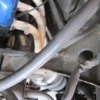MANGUSTA RIDE AND HANDLING ABSOLUTELY MUST DO:
_______________________________________________
GREASE THE UPPER FRONT BALL JOINT
This joint will stiffen and ultimately break if not serviced. It is hidden under the outboard end of the upper A-arm. Remove the three 8mm bolts, lift the A-arm and remove the small bolt at the top of th ball joint. Insert a Zirc fitting and grease the joint on a regular basis.
#2
INSTALL NEW FRONT MOTOR MOUNTS
Bad mounts allow the engine mass to shift causing very storage ride motions and weight transfer that is unnerving at high speeds, especially in corners. Do not drill the old mount through and put a long bolt through it as that only damps the movement on the downward motion with no control on the upward jounce.
#3
INSTALL NEW BRIDGE BUSHINGS
The is critical to avoiding the positive / negative camber shift that some cars have had. The source of this problem is the small steel encased bushings at each end of the large rear bridge behind the engine. Worn bushings allow the transfer of forces through the bridge from one rear wheel to the other. Go to one of the websites that feature synthetic, harder, bushings for replacements. Good bushings will also diminish the feeling of weight bias. Make sure the top bushings in the hub carriers are tight.
#4
INSTALL AN ADJUSTABLE PROPORTIONING VALVE IN THE FRONT BRAKE SYSTEM
The front brakes will lock under panic braking. To correct this install a commercially available adjustable brake proportioning valve in the front brake system. (NOT the rear).
INSTALL NEW BRAKE PADS.
#5
Have new brake pads made by one of the performance companies that are very soft. This will enhance the braking significantly. Hard pads last a long time but do not take advantage of the large calipers and discs.
#6
INSTALL A COOLANT RECOVERY SYSTEM
A coolant recovery system will completely fill the cooling system providing more cooling capacity and eliminating air that rots the rubber hoses. Use a 7 pound cap to facilitate coolant movement as the higher the pressure in the system the more resistance there is to moving the coolant from front to rear.
#7
INSTALL A NEW BRAKE PEDAL RETURN SPRING
This will scare you when you look at it. Take the cover off the hydraulic bottle compartment and then remove the whole thing, about seven screws. There might be a number for your car under there in white chalk. Look at the small spring attached to the front of the booster at the top of the brake pedal. If it breaks, and it will at about 32,000 miles, you will have a brake failure and if you cannot pull the pedal back quick enough with your toe you will crash. I created a whole new spring set-up with three small springs. Luckily it failed for me at a red light with no one in front of me and no traffic.
Original Post


